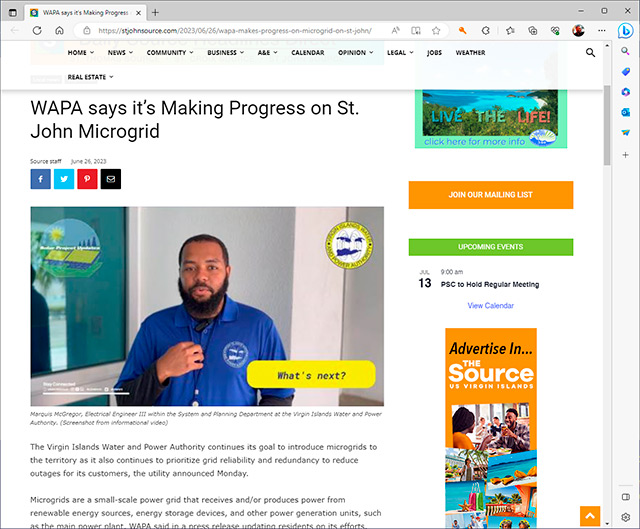The Virgin Islands Water and Power Authority continues its goal to introduce microgrids to the territory as it also continues to prioritize grid reliability and redundancy to reduce outages for its customers, the utility announced Monday.
Microgrids are a small-scale power grid that receives and/or produces power from renewable energy sources, energy storage devices, and other power generation units, such as the main power plant, WAPA said in a press release updating residents on its efforts.
Among the range of benefits, microgrids will enhance the resilience of WAPA’s local energy supply by providing backup power during grid failures, such as loss of generation at the Richmond power plant on St. Croix or the Randolph Harley power plant
on St. Thomas, or outages caused by vehicle accidents or overgrown trees, the release stated. Further, microgrids can also operate independently and continue supplying electricity to critical areas-for instance, hospitals during a tropical storm-improving
reliability and reducing service disruptions, it said.

Original Post
On St. John, where WAPA intends to introduce its first of three microgrids in the territory, a feasibility study began earlier this year in February, the release stated. Taking the lead on the first step of this project, the utility’s System Planning
Department is collaborating with contractors E Plus, National Renewable Energy Laboratory and Sargent & Lundy to assess the current microgrid project proposal for St. John. It is expected to include four megawatts of renewable solar generation,
an emergency generation unit, and corresponding battery energy storage system, or BESS, according to the release.
“The team and I are diligently at work on these microgrid projects for the territory,” stated Marquis McGregor, Electrical Engineer III within the System and Planning Department. “We are most excited about the potential and possibilities
as these projects come to a close with what we’ll be able to do with BESS as well as the alternative energy resources,” he said.
Upon completion of the feasibility studies, findings will be submitted to the Federal Emergency Management Agency for review and approval, followed by design, procurement and construction, the release stated. The current microgrid project slated for St.
John will be funded 90 percent through FEMA with a 10 percent local match, it said.
On St. Thomas and St. Croix, project proposals are underway, and information will be forthcoming as WAPA implements steps towards improved energy efficiency, reduced transmission losses, integration of renewable energy sources, and enhanced grid resilience,
the release stated.
See the informational video below: